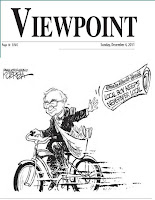Yesterday's
Charlotte Sun-Herald editorial, "Day of Infamy Followed by Greatest Resolve," praises veterans who responded to the Japanese attack on Pearl Harbor. About halfway into the editorial, the writer calls Dec. 7, 1941 the "trigger" that began the era called "The American Century."
No it didn't. The allusion is to "The American Century," Henry R. Luce's five-page editorial in
Life m magazine that ran Feb. 17, 1941 -- ten months before Pearl Harbor.
Furthermore, if the editor were to actually read the article from which he takes his praise, he might recognize its profound naivete and thinly veiled jingoism. Under a subheading worthy of Genesis, Luce describes "America's Vision of Our World ... How it shall be created." He identifies American "prestige" as the light emanating from Hollywood, jazz, slang and "patented products." American artifacts are "the only things that every community in the world ... recognizes in common," Luce claims as if this is a good thing.
Luce's shaping thesis is the United States had entered a war (on the European front -- Pearl Harbor had not happened yet) that has the potential of bringing into focus an era of achievement. "The American Century" is not Luce's reference specifically to war, but to "four propositions." Luce's propositions are that the world is indivisible; the war has the potential to destroy humankind; the world can now produce "all the material needs of the entire human family;" and "the world of the 20th Century, if it is to come to life with any nobility of health and vigor, must be to a significant degree an American Century."
From that point, Luce goes on to lay out an American-centric view of the near future: America will deploy "engineers, scientists, doctors," as well as people he calls "movie men, makers of entertainment, developers of airlines." He rounds out the list with teachers and educators. His vision is that this American horde will be "eagerly welcomed" because they have "underake[n] to be the Good Samaritan of the entire world." Luce proclaims "the manifest duty of this country to undertake to feed all the people of the world... a humanitarian army of Americans..."
The tenor and content of Luce's "The American Century" ring hollow.
Sun editors have the benefit of having studied half century of history since. Surely they see the havoc we wreak every time we try to remake one part of the globe or another in our own image. Too bad no one at the
Charlotte Sun took the time to check out the history and context of the infamous phrase.
 "There are those in our community who exemplify the true mean of the season."
"There are those in our community who exemplify the true mean of the season."










